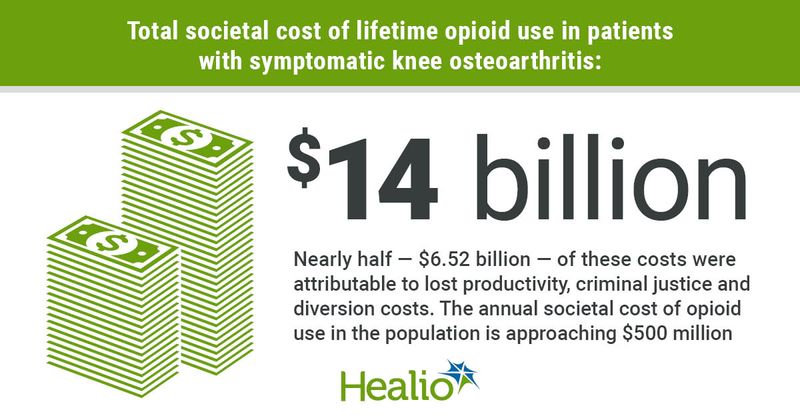Opioid use among patients with knee osteoarthritis costs US society $14B
The societal cost of total lifetime opioid use in patients with knee osteoarthritis is approximately $14 billion, nearly half of which is due to lost work productivity, diversion and criminal justice costs, according to data.
“Symptomatic knee osteoarthritis (SKOA) is a leading cause of chronic musculoskeletal pain for which opioids are frequently prescribed in the USA; as many as 858,000 patients with knee OA may use opioids chronically for pain management,” Jamie L. Huizinga, BS, of Brigham and Women’s Hospital, in Boston, and colleagues wrote in Arthritis Care & Research. “Current treatment guidelines do not recommend opioid use for knee OA, based on a growing body of evidence questioning the utility of opioids for long-term pain management. Additionally, opioid use is not cost-effective for management of knee OA pain.”

“Lastly, Zhao et al. [in the Journal of Medical Economics] demonstrated that, compared to other OA patients in the USA, those using opioids missed significantly more workdays, resulting in annual incremental wage loss of $1,395,” they added. “A recent analysis of data from the Medicare Current Beneficiary Survey (MCBS) found that chronic opioid use among knee OA patients decreased from 12% in 2013 to 4% in 2016. Despite these encouraging changes in opioid prescription practices, even a small proportion of SKOA patients in the USA using opioids chronically likely results in a large societal cost.”
To analyze the societal economic burden of opioid use among patients with symptomatic knee OA, Huizinga and colleagues used the Osteoarthritis Policy Model, a validated computer simulation of the disease’s natural history and treatment. For their simulation, the researchers included direct medical costs, lost work productivity, diversion — or the illicit sharing of opioids from those with prescriptions to those without — and criminal justice costs. The cohort with symptomatic knee OA was modeled to have a mean age of 54 years and a Western Ontario and McMaster University (WOMAC) pain score of 29.
The researchers estimated the annual costs of strong and weak opioid regiments — set at $1,381 and $671, respectively — using Medicare fee schedules, Red Book, the Federal Supply Schedule and published literature. The annual lost productivity and criminal justice costs stemming from opioid use disorder were set at $11,387 and $4,264 per‐person, respectively, and obtained from published literature. The researchers estimated the prevalence of opioid use disorder based on the 2015‐2016 Medicare Current Beneficiary Survey. They then used sensitivity analyses to assess the robustness of their estimates.
According to the researchers, assuming a 5.1% prevalence of chronic strong opioid use, the total lifetime cost attributable to patients with symptomatic knee OA is approximately $14 billion. Just 53% — or $7.45 billion — of this total stemmed from direct medical costs. Meanwhile, $6.52 billion in costs were attributable to lost productivity, criminal justice and diversion costs. Diverted opioid prescriptions alone represented 35% of the lifetime opioid-related cost for each opioid user with symptomatic knee OA.
The researchers also found that, as strong opioid use among those with symptomatic knee OA decreased from 11.6% to 1.8% between 2013 and 2020, the total lifetime opioid-related cost decreased from $28.5 billion to $6.1 billion.
“Although current guidelines do not recommend opioid use for knee OA pain management, we estimate that the USA knee OA population generates $14.0 billion in opioid-related costs over their lifetime, approaching $0.5 billion annually,” Huizinga and colleagues wrote. “This represents 4% of all SKOA related costs.
“Our results provide additional evidence of the substantial economic burden of opioid use for knee OA pain management and the potential savings from preventing opioid use, supporting guidelines recommending against such use,” they added. “Reducing opioid use may lead to lower opioid-related and overall knee OA costs for knee OA opioid users and the USA SKOA population.”

